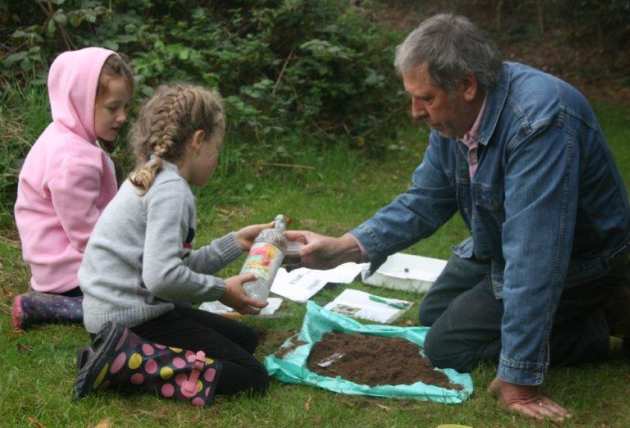Soil and Earthworm Survey
 Soil is one of the world’s most precious natural resources. It is vital for plant growth, providing food and materials for humans and animals; it regulates water by filtering out pollutants and can reduce flood risks; and it is home to a vast array of animals. Despite all these vital functions, much less is known about soil than air or water. Soil is made up of water, air, minerals and organic matter. Soil properties are influenced by the bedrock beneath it, the local environment, the plants that grow on it, and the animals that move through it. Of these animals, earthworms are one of the most important to soil structure and fertility.
Soil is one of the world’s most precious natural resources. It is vital for plant growth, providing food and materials for humans and animals; it regulates water by filtering out pollutants and can reduce flood risks; and it is home to a vast array of animals. Despite all these vital functions, much less is known about soil than air or water. Soil is made up of water, air, minerals and organic matter. Soil properties are influenced by the bedrock beneath it, the local environment, the plants that grow on it, and the animals that move through it. Of these animals, earthworms are one of the most important to soil structure and fertility.
The OPAL Soil and Earthworm Survey was created to find out more about soil and earthworms and investigate the relationships between earthworm species and habitats and soil types.
The survey contains five activities:
- Digging a soil pit to take a soil sample
- Investigating the properties of the soil sample (e.g. hardness, moistness, pH, texture)
- Recording the different species of earthworm
- Searching for earthworms in other habitats
- Recording other organisms found in the soil sample
Survey Resources
Welsh Language Versions
Survey Results
In total over 5,510 responses were submitted online for the OPAL Soil and Earthworm Survey. Some of the key findings include:
- Domestic gardens were hotspots for earthworms, with high numbers compared with other habitat types. Gardens also had the highest average number of species.
- Rural gardens had a greater number of earthworms and a greater number of species than urban gardens. However, urban gardens had more earthworms than other urban habitats.
- The worm species reported at the greatest number of sites were the grey worm, redhead worm and lob worm.
- Man-made materials were present in the topsoil in over a third of survey locations and these were predominantly composed of construction material.
Academic papers
- Bone, J., Barraclough, D., Eggleton, P., Head, M., Jones, D.T. and Voulvoulis, N. (2014) Prioritising Soil Quality Assessment Through the Screening of Sites: the Use of Publicly Collected Data. Land Degradation and Development. Land degradation & development, 25(3): 251-266.
- Bone, J., Archer, M., Barraclough, D., Eggleton, P., Flight, D., Head, M., Jones, D.T., Scheib, C. and Voulvoulis, N. (2012) Public participation in soil surveys: lessons from a pilot study in England. Environmental Science and Technology, 46 (7): 3687–3696.
- Bone, J., Head, M., Jones, D.T., Barraclough, D., Archer, M., Scheib, C., Flight, D., Eggleton, P. and Voulvoulis, N. (2011) From Chemical Risk Assessment to Environmental Quality Management: The Challenge for Soil Protection. Environmental Science and Technology, 45 (1): 104-110.
- Bone, J., Head, M.K., Jones, D.T., Barraclough, D., Archer, M., Scheib, C., Flight, D., Eggleton, P. and Voulvoulis, N. (2010) Soil Quality Assessment Under Emerging Regulatory Requirements. Environment International, 36 (6): 609-622.




